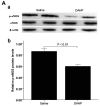Downregulation of tetrahydrobiopterin inhibits tumor angiogenesis in BALB/c-nu mice with hepatocellular carcinoma
- PMID: 27279530
- PMCID: PMC4933545
- DOI: 10.3892/or.2016.4850
Downregulation of tetrahydrobiopterin inhibits tumor angiogenesis in BALB/c-nu mice with hepatocellular carcinoma
Abstract
Hepatocellular carcinoma (HCC) is a highly vascular tumor, and treatment options for patients of advanced-stage are limited. Nitric oxide (NO), which is derived from endothelial nitric oxide synthase (eNOS), provides crucial signals for angiogenesis in the tumor microenvironment. Tetrahydrobiopterin (BH4) is an essential cofactor eNOS and represents a critical determinant of NO production. To examine whether treatment of 2,4-diamino-6-hydroxypyrimidine (DAHP) inhibits angiogenesis of HCC, BALB/c-nu mice were injected with HepG-2 cells with DAHP. Supplemental DAHP treatment decreased K-ras mRNA transcripts, inhibition of phosphorylation of eNOS and Akt, inhibition of guanosine triphosphate cyclohydrolase (GTPCH), and decreased significantly NO synthesis, and then inhibited angiogenesis, compared with the results observed in the saline group. Histopathology demonstrated angiogenesis and tumor formation were significantly inhibited in HCC. DAHP downregulates GTPCH protein expression, corresponding to decreased levels of BH4 and the contents of NO. In addition, DAHP downregulates eNOS and Akt protein expression, corresponding to decreased eNOS phosphorylation at Ser1177 and Akt phosphorylation, compared with the saline control. We suggest that DAHP, recognized as a specific competitive inhibitor of GTPCH, can decrease tumor BH4 and NO by the inhibition of the wild-type Ras-PI3K/Akt pathway, and then inhibiting angiogenesis, and may provide a novel and promising way to target BH4 synthetic pathways to inhibit angiogenesis and to control potential progression of HCC. Whether DAHP has a therapeutic potential will require more direct testing in humans.
Figures












References
-
- Marinos RS, Zhang W, Wu G, Kelly KA, Meininger CJ. Tetrahydrobiopterin levels regulate endothelial cell proliferation. Am J Physiol Heart Circ Physiol. 2001;281:H482–H489. - PubMed
MeSH terms
Substances
LinkOut - more resources
Full Text Sources
Other Literature Sources
Medical
Molecular Biology Databases
Research Materials
Miscellaneous

